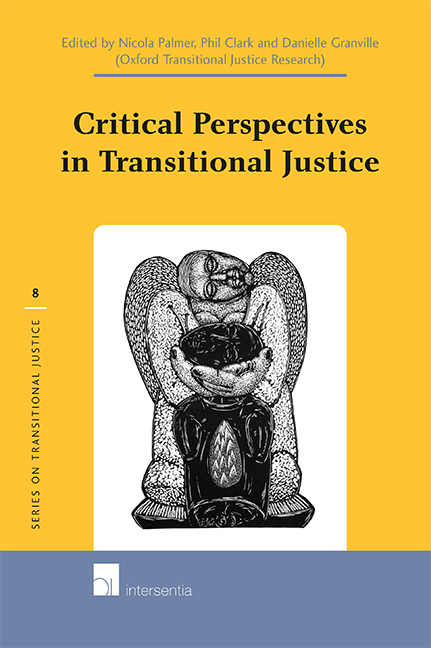Book contents
- Frontmatter
- Note
- Acknowledgements
- Contents
- Abbreviations
- Introduction
- Section 1 Critiquing Core Concepts in Transitional Justice
- Section 2 Accountability, Human Rights and the Rule of Law
- Section 3 Locality and Legitimacy
- Section 4 Memory, Ritual and Apology
- Section 5 Transitional Justice After Transition
- Contributors’ Biographies
- Series on Transitional Justice
10 - Can International Justice Be Restorative Justice? The Role of Reparations
Published online by Cambridge University Press: 22 December 2020
- Frontmatter
- Note
- Acknowledgements
- Contents
- Abbreviations
- Introduction
- Section 1 Critiquing Core Concepts in Transitional Justice
- Section 2 Accountability, Human Rights and the Rule of Law
- Section 3 Locality and Legitimacy
- Section 4 Memory, Ritual and Apology
- Section 5 Transitional Justice After Transition
- Contributors’ Biographies
- Series on Transitional Justice
Summary
INTRODUCTION
Recent decades have seen a gradual shift in international criminal law towards greater victim recognition and centrality, which in many respects parallels the rise of victims’ rights and restorative justice (RJ) in Western national criminal justice systems. Since the start of the twenty-first century the UN has issued Basic Principles on the Use of Restorative Justice Programmes in Criminal Matters (adopted under resolution 2002/12) and, in 2006, the UN Handbook on Restorative Justice. We are witnessing the appearance of RJ-styled objectives – whether implicitly or explicitly – in a number of UN resolutions and international instruments (e.g., the 200 Basic Principles and Guidelines on the Right to a Remedy and Reparation for Victims of Gross Violations of International Human Rights Law and Serious Violations of International Humanitarian Law (the 2006 Basic Principles) and the Rome Statute of the International Criminal Court (the Rome Statue)). There has also been an increasing focus on RJ in the academic and jurisprudential discourse surrounding international criminal tribunals, courts and transitional justice more generally. The growing prominence of RJ within this context – and in particular the introduction of material and symbolic reparations – flows, to some extent, from the recognition that ‘justice,’ in response to crimes against humanity, requires more than the myopic application of traditional (often Western-styled) paradigms of retributive and deterrent justice. It must instead encompass forms of justice (embracing notions such as truth, reconciliation, and reparation) aimed not only at punishing offenders, but also healing victims and repairing communities in which the social fabric, as well as the economic and physical infrastructure has, in many cases, been torn apart.
The growing prominence of RJ in international criminal law and transitional justice has coincided with increasing regret expressed by many criminologists and criminal justice practitioners at the reluctance of legislators and policy makers in domestic criminal justice settings to recommend RJ for anything but quotidian categories of crime. However, while RJ has been kept largely within the shallow end of domestic criminal justice, criminologists have, by and large, failed to engage with the challenges posed to RJ from crimes against humanity.
- Type
- Chapter
- Information
- Critical Perspectives in Transitional Justice , pp. 189 - 210Publisher: IntersentiaPrint publication year: 2012
- 2
- Cited by



